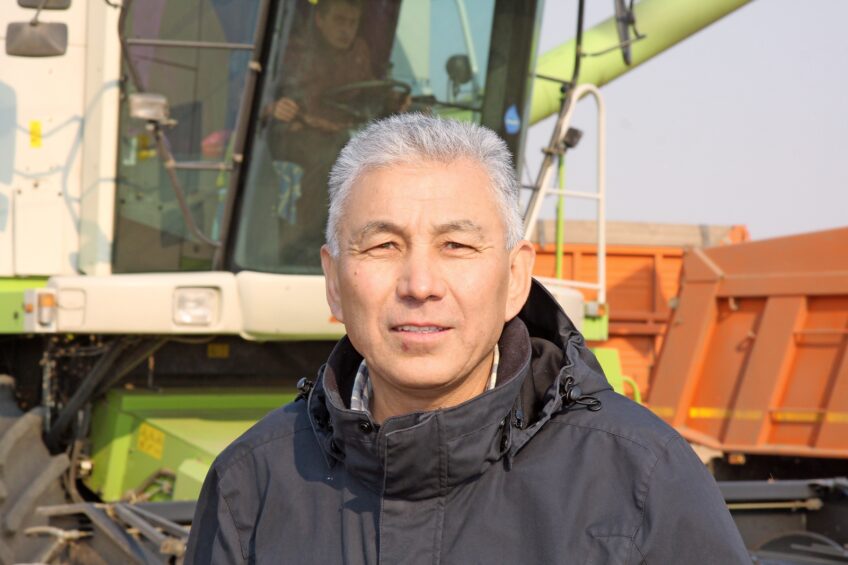Western perspective makes Kolkhoz future proof

Livestock and crop farmer Kuanysch Rakischev runs his Kazakh farm by using techniques and genetics from the West. Even the farm employees are trained there.
Kazakhstan encourages farmers to start new farms and dairy processing operations, so that the country can be more self-sufficient for dairy products.
Subsidy on Kazakh dairy products
The Kazakh government subsidises dairy to a great extent, and agricultural entrepreneur Kuanysch Rakischev took this opportunity to renovate his old cowshed for 100 cows. He also built a new, bigger and more modern shed, suitable to house 600 cows and inspired by Western European techniques. The ration of cows consists of grass, maize and whole plant silage. The stable of 600 cows is mostly populated with Fleckvieh cattle. According to Rakischev this robust breed is better able to cope with the extreme low temperatures in winter (up to minus 30 degrees), compared to Holstein cows.
Labour prevents rural exodus
In 1999, the former farm (also known as ‘kolkhoz’ or collective farm) was privatised and divided among the employees. However, in 2003 the company went bankrupt through mismanagement. Then Rakischev took over the company and is currently the sole shareholder of the farm. The company’s main activity is crop farming, but Rakischev extended the dairy part of the farm to offer year-round work for his employees. An employee earns 80,000 tenge per month (which is around €400). A portion of the salary is also paid in goods, such as animal feed for backyard farming, done by the villagers and coal for heating.
Earmarks are not compulsory
In one of the barns, igloos for calves can be found. Since last year, the igloos are placed under cover, to prevent snow entering the igloos, which happened before. In the corner of the barn there is a kind of ‘oven’. The farmer explains that this is a dryer in which new-born calves are dried to prevent them from getting too cold during winter times. Remarkably, ear tags are not required by law. Yet, Rakischev uses ear tags for each calf with its date of birth on it. It helps him to have a good registration system. The free stall cows are milked twice a day in a 2 × 12 herringbone parlour from GEA. Next to the milking parlour, the farmer has a small office, where a registration program of GEA keeps track of the milk production of all cows.
Proud of the farm
The farmer knows exactly what he does and does not want to share with the outside world. Despite the registration program recording everything, he is not so keen to share some of the key figures, such as cost price. Kazakh entrepreneurs are proud of their farms and are open to share what they are doing. At the same time, they seem extremely careful with the sharing of key figures and financial results. People that are pioneering are often in the spotlight, and in Kazakhstan, other people often want to benefit from you. It looks like, Kazakh farmers prefer to lie low.
Kazakh ‘grazing’
The packaging of Kazakh milk and yoghurt products in supermarkets in the capital Astana almost look Western European: grazing cows in green pastures, with a traditional barn in the background. Although Rakischev has enough space around the farm, cows are not grazing outdoors. The dry hot steppes are not suitable for that. But unlike many Kazakh colleagues, Rakischev’s cattle do go outside during the day to an enclosed sandy plot. This is good for animal health, according to the farmer. Rakischev wants to step up the genetics of the cows. He also aims to increase the quality of the concentrate feed production. The training of his employees is very important to the farmer. The main veterinarian was send to Germany for one year to get updated on animal husbandry and animal nutrition.
Dairy processor is a 500km drive
The milk is sold to the French dairy group Lactalis, which also operates in Kazakhstan. The plant is located in Pavlodar, 500 kilometres away from the farm. In Kazakhstan, such a distance from farm to processor is not uncommon. Rakischev produces 8,000 to 9,000 litres of milk per day. Despite the fact that Kazakhstan is not self-sufficient, the price of milk has dropped considerably over the last months. Last year the price was still €0.60 per litre, now it has fallen to just over €0.30. In addition, the state pays a subsidy of €0.08 per litre. Despite the fact that Rakischev doesn’t want to share the cost price, he does mention that it is still profitable to continue farming with the €0.38 per litre of milk he is receiving. His ambition to grow is therefore still very much alive. Rakischev wants to build a new barn for another 1200 cows.
Join 13,000+ subscribers
Subscribe to our newsletter to stay updated about all the need-to-know content in the dairy sector, two times a week.











